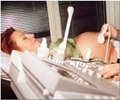- Placental Abruption - (http://americanpregnancy.org/pregnancy-complications/placental-abruption/)
- Information about placental abruption - (https://www.tommys.org/pregnancy-information/pregnancy-complications/information-about-placental-abruption)
- Placental abruption - (https://www.betterhealth.vic.gov.au/health/healthyliving/placental-abruption)
What is Abruptio Placenta?
Abruptio placenta or placental abruption is a serious but uncommon complication of pregnancy. The placenta separates either partially or completely from its attachment to the inner lining of the uterus before the birth of the baby.
Abruptio placenta is an important cause of antepartum hemorrhage (genital tract bleeding occurring between 24 weeks pregnancy to term) and can compromise oxygen and nutrient supply to the fetus as well as result in severe maternal blood loss. It usually occurs suddenly and needs urgent management.
The incidence of placental abruption is approximately 0.2–1 percent of all pregnancies. The majority of placental abruptions are diagnosed before 37 weeks gestation, and about 14 percent occur before 32 weeks gestation
The Normal Placenta
The placenta is a flat round organ that forms in the uterus during pregnancy and is responsible for exchange of oxygen, nutrients, and waste products between the mother and fetus. Additionally, it is an endocrine organ and synthesizes important hormones and neurotransmitters and acts as a barrier to toxins and infection in the fetus. It is formed from both maternal and fetal tissue, with about one fifth derived from fetal tissue at term. In a normal pregnancy, the placenta remains firmly attached to the inner wall of the uterus until after the baby’s birth.
What are the Causes/Risk Factors of Abruptio Placenta?
The exact cause of placental abruption is unclear. Possible causes include injury to the abdomen (fall or auto accident) or sudden loss of the amniotic fluid that surrounds and cushions the baby in the womb.
Factors that increase the risk of placental abruption include the following -
- High blood pressure (either long term or pregnancy induced) is the biggest risk factor
- Previous history of abruptio placenta
- Smoking during pregnancy
- Maternal age over 40 years
- Multiple pregnancy
- Short umbilical cord
- Scar in the uterus from previous surgery where placenta is attached
- Cocaine use
- Uterine infection during pregnancy

What are the Symptoms and Signs of Abruptio Placenta?
Placenta abruptio usually occurs in the third trimester of pregnancy (24 weeks onwards), especially the final few weeks before delivery. However, it can occur at any time after the 20th week of pregnancy. The clinical features of abruptio placenta include the following -
- Mild to severe vaginal bleeding
- Abdominal pain
- Painful contractions in lower back and belly that are continuous
- Painful and tender uterus that feels firm to hard
- Uterus appears large for duration of pregnancy
- Decreased fetal movement
- Decreased fetal heart rate
Occasionally, placental separation occurs gradually and presents with light intermittent vaginal bleeding in late pregnancy.

How do you Diagnose Abruptio Placenta?
It is not easy to diagnose abruptio placenta. It may be suspected when a pregnant woman develops sudden localized abdominal pain with or without vaginal bleeding.
The diagnosis is usually one of exclusion and therefore other causes of abdominal bleeding have to be ruled out as well. The other cause of antepartum hemorrhage namely placenta previa should also be borne in mind.
Imaging
An ultrasound abdomen in the mother may sometimes demonstrate abruptio placenta but it can rule out placenta previa and other causes of third trimester bleeding. Ultrasound scan is a form of imaging that employs sound waves to produce images of the organs to detect the presence of any abnormalities.
Magnetic resonance imaging (MRI) scan (imaging test that uses magnetic field) has been found to be sensitive in picking up abruptio placenta and can be considered if ultrasound is not diagnostic.

Fetal Monitoring
Fetal heart rate has to be regularly monitored for evidence of fetal distress and to check for uterine contractions and resting uterus tone
Blood Tests
Maternal hemoglobin and hematocrit to check for anemia and hemodynamic status due to blood loss and for appropriate management as needed depending on the severity of her condition.
Maternal blood group and typing in case blood transfusion should be necessary
Renal function tests to monitor kidney function
Coagulation profile to check for development a known serious complication of APH namely disseminated intravascular coagulation (DIC)
What are the Complications of Abruptio Placenta?
Abruptio placenta can pose serious health risk both to the mother as well as the fetus. These include the following -
Maternal Complications
- Hypovolemic shock due to increased blood loss
- Clotting disorder (disseminated intravascular coagulation)
- Multiple organ failure resulting from significant blood loss
- Rarely, when uterine bleeding is not controlled, surgical removal of uterus (hysterectomy) may be necessary
Fetal Complications
- Fetal growth retardation due to inadequate nutrients
- Fetal asphyxia due to low oxygen
- Preterm birth (birth of baby before 37 weeks) and low birth weight
- Stillbirth
- Learning and developmental issues later in life

How do you Treat Abruptio Placenta?
Treatment of abruptio placenta depends on the severity of the bleeding, condition of mother and baby and the duration of pregnancy
Pregnancy Close to Term (34 weeks onwards)
- If abruption is mild and there is no fetal distress, the woman can be admitted in a hospital and monitored closely for trial of vaginal delivery with the option of cesarean delivery if required
- For moderate to severe abruption with evidence of fetal distress or if the woman has lost blood, admission to hospital with blood transfusion and intensive monitoring with preparations for cesarean delivery may be necessary to deliver the baby safely
Pregnancy Not Close to Term
- If abruptio placenta is mild, and there is no fetal distress, the woman may be sent home and kept under close monitoring. Medications may be given to cause fetal lungs to mature if early delivery becomes necessary
- For moderate to severe abruption, urgent delivery by cesarean section is advised with close monitoring of maternal hemodynamic status. Blood transfusion may be given in case of severe blood loss
- If the baby is delivered preterm, it has to be monitored in the neonatal ICU with ability to handle the special needs of preterm babies
How do you Prevent Abruptio Placenta?
Placental abruption cannot be prevented but precautions to reduce the modifiable risk factors may decrease its occurrence. These include -
- Avoid smoking during pregnancy
- Avoid using cocaine or other illegal drugs
- Proper control of hypertension
- Have regular antenatal checkups
- Take folic acid supplements during pregnancy
- If you have previous history of antepartum hemorrhage, discuss with your doctor on how to reduce risk during current pregnancy










